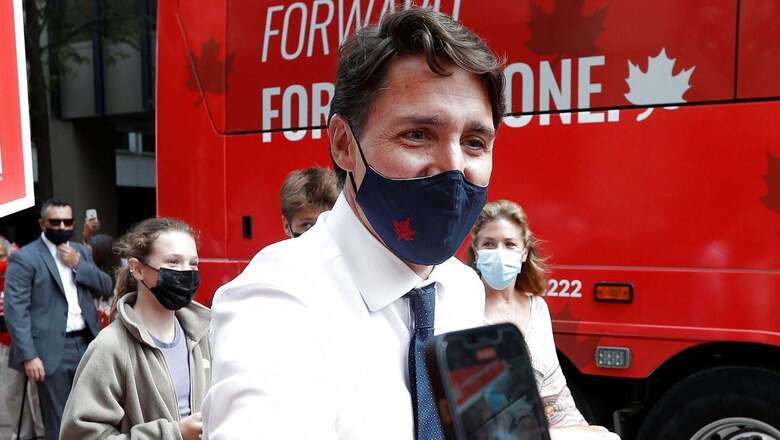
views
I was posted as High Commissioner in Ottawa when the telegenic Justin Trudeau led his Liberal Party to victory in September 2015. He had single-handedly revived the fortunes of his party, unseating the formidable Conservative incumbent Stephen Harper who had been in the saddle for 9 years, on a promise of change. He seemed to have the Midas touch and was incapable of doing any wrong.
How the sheen wears off! During the sole English-language debate among the leaders of five prominent political parties on September 9, Mr Trudeau was at the receiving end from all quarters. He deflected pointed questions and was hard put to justify his decision to call midterm polls in the hope of extending his tenure by an additional two years.
He may have been inspired by his father, Prime Minister Pierre Trudeau, who had similarly opted for snap polls in 1974 and managed to form a majority government. However, the young Trudeau overlooked a ‘minor’ detail. The nation is on the cusp of the fourth wave of the dreaded Covid-19 pandemic.
Why did Mr Trudeau recommend the dissolution of the House of Commons? A bit of background is in order. The 2019 election did not go well for the Prime Minister. The Conservative opposition under the lacklustre Andrew Scheer garnered more popular votes than the Liberals, yet could not become even the largest party given the way the ridings (constituencies) are configured. The Liberals lost their majority but emerged as the largest party and were dependent on smaller parties like Bloc Quebecois (BQ) and NDP (National Democratic Party) for support, which of course came with riders.
Mr Trudeau was determined to regain his majority even though the poll-weary political parties were careful about not rocking the Liberal boat. But, by now, public opinion was turning sour due to the perception that the government had been sluggish in handling the Covid-19 outbreak. A huge country, with a minuscule population of 38 million, saw the number of daily afflictions rise from 1,700 in April to 4,000 in October and raging at 10,000 in December 2020.
Canada had intriguingly contracted for 400 million doses against a requirement of under 80 million but was facing delays in receiving the shipments when Mr Trudeau called Prime Minister Narendra Modi in February 2021 for emergency supplies. Half a million units were made available with dispatch prompting the Canadian leader to tweet that if the world managed to conquer Covid-19, “it would be significantly because of India’s tremendous pharmaceutical capacity, and Prime Minister Modi’s leadership in sharing this capacity with the world”.
Notwithstanding the initial hiccups, 73.77% of Canadians have received at least one dose of Covid-19 vaccine and 67.80% have been fully vaccinated, as of September 4, 2021, which is one of the highest in the world. However, there is unexpected resistance from young adults in the age group of 18 to 29, which is a complicating factor if the fourth wave does engulf Canada.
Canada sought to contain the pandemic through complete or partial lockdowns and a slew of measures like other nations, which led to the shutting down of small businesses. Employees were laid off and joblessness grew. The Prime Minister sensed a huge opportunity to win hearts and minds by opening up the government coffers. Some 8 million unemployed and underemployed residents (including non-citizens) received up to 2,000 dollars a month in financial assistance. The assistance was so generous that a large percentage of the beneficiaries stopped looking for work or refused to take up jobs that paid less than the handout. As a result, gradually businesses began to suffer, serious manpower shortages were reported, inflation flared up and fiscal deficit reached historic highs.
During the debate, Conservative leader Erin O’Toole effectively turned the screws on the Prime Minister in highlighting that the government was borrowing 424 million dollars every day. The common refrain across the country is that Mr Trudeau lavished billions of Canadian dollars in his endeavour to buy a majority and took advantage of a health crisis.
“Canada’s budget deficit in fiscal 2020/21 swelled to C$314.00 billion ($260.15 billion) from a deficit of C$21.77 billion in the previous year” reports Reuters, while “revenues dropped 10.4%”. This is the highest deficit since the Second World War. Canada with a GDP of $1.74 trillion can ill afford such a burden. The large businesses and people earning above two hundred thousand dollars a year are dreading the consequences.
There is palpable anger among the citizens that a completely unnecessary poll has been foisted on them. So much so that last week gravel was thrown at the Prime Minister, which is unprecedented in the country that prides itself on holding peaceful and civilised elections. Fortunately, all political parties immediately condemned the incident.
A recent Angus Reid Institute survey indicated a drop in popularity for Mr Trudeau among voters of every age and gender, including women who have been his staunch supporters. Writes The Telegraph’s US Editor Nick Allen: “[Critics] see him as a very privileged person who doesn’t quite understand the lives of ordinary Canadians.”
Be that as it may, Mr Trudeau remains a hot favourite of ethnic minorities in Canada, in which he has invested heavily even at the cost of displeasing the white majority. Canada is home to some 2 million persons of Indian origin (PIO) comprising 5.6% of the country’s population. A majority of them, including 80% of Sikhs, have traditionally supported the Liberals.
The outgoing house has 22 PIO parliamentarians and three ministers. Indian-Canadians are prominent in all walks of life, especially in politics. Indian students have been making a beeline to Canada. Estimated at 220,000, they are the largest segment among the international students in the country.
The Canadian pension funds with a combined corpus of close to 1 trillion dollars have been betting big on India and have already invested over C$50 billion. Our economies are complementary: over 1,000 Canadian companies operate in India and a Comprehensive Economic Partnership Agreement, which is in the works, can give a much-needed boost to our economic ties. As such, there is significant interest in the Canadian elections, and Mr Trudeau’s future, in India.
The Prime Minister can still turn the tables on the opposition. He had surprised the pundits by emerging as the single-largest party, defying predictions. In recent days, the meagre 3% lead of the Conservatives over the Liberals has started to shrink. If the turnout is low as anticipated (it was 66% the last time around), it would be to Mr Trudeau’s advantage as the committed Liberals will come out to vote in any case.
Whether he would make his late father proud or succumb as British PM Theresa May, who had similarly wagered her office by calling for snap polls, would be known not before the morning of September 21. The prevailing wisdom is that Mr Trudeau will eke out a slender lead over the Conservatives, with a majority eluding him again. That would further erode his standing, embolden the opposition, and perhaps commence the countdown for yet another general election in 12 to 18 months. That said, in democracies, one should never underestimate the wisdom of the common man, who often has the last laugh.
The author is Former Envoy to South Korea and Canada and Official Spokesperson of the Ministry of External Affairs. The views expressed in this article are those of the author and do not represent the stand of this publication.
Read all the Latest News , Breaking News and Ukraine-Russia War Live Updates here.

















Comments
0 comment